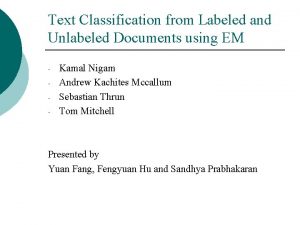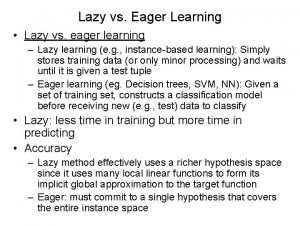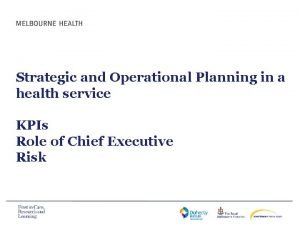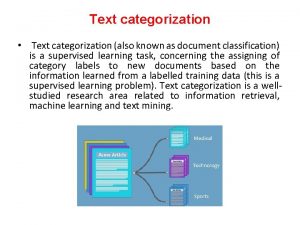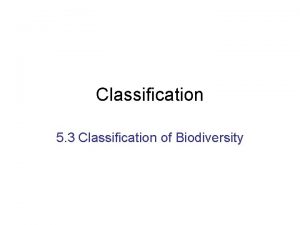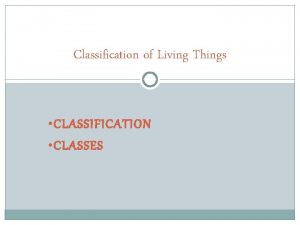OPERATIONAL EMERGENCY CATEGORIZATION AND CLASSIFICATION Operational Emergency An















- Slides: 15

OPERATIONAL EMERGENCY CATEGORIZATION AND CLASSIFICATION

Operational Emergency An Operational Emergency (OE) is a major unplanned or abnormal event or condition that • Involves serious health and safety or environmental impacts • Requires resources from outside the immediate/affected area to supplement the initial response • Requires time urgent notifications to initiate response activities

Key Elements of an Operational Emergency Include • Recognize the situation • Categorize • Classify • Notify • Respond • Protect workers and the public • Mitigate the event • Recover

Range of Emergency Events Types of emergency events include • Accidents (i. e. , radioactive, chemical, and biological releases) • Security events (i. e. , hostile attack, terrorism, sabotage, or malevolent acts) • Natural phenomena • Mass casualties

OE Categorization An OE event or condition must be categorized as promptly as possible but no later than 15 minutes after event recognition, identification, and/or discovery Categorization is intended to • Ensure rapid dissemination of event facts outward and upward • Activate response activities beyond the local event scene • Meet time-sensitive information needs of strategic decision-making in areas of national security

OE Classification How categorization and classification are intertwined • An OE event or condition involving hazardous materials that requires classification needs to be categorized and classified as promptly as possible, but no later than 15 minutes after event recognition, identification, and/or discovery • Classified emergencies are a subset of the OE category • When an event is classified, it is (by definition) also simultaneously categorized as an OE

OE Classification (cont. ) The basis for OE classification includes information from the following resources and derived from the DOE O 151. 1 C definitions of classified Operational Emergencies: • Emergency Planning Hazards Assessments (EPHAs) o Emergency Action Levels (EALs) • North American Emergency Response Guidebook (NAERG)

OE Classification (cont. ) An OE is classified when events occur that represent a significant degradation in the level of safety at a site/facility and that require timeurgent response efforts from outside the site/facility • Health and Safety • Environmental • Safeguards and Security • Offsite DOE Transportation

Event Classification Involves • A consistent method to implement preplanned actions to ensure a graded response to emergency situations • Material-specific Protective Action Criteria (PAC) for event classification

Event Classification An OE involving the actual or potential airborne release of hazardous material is classified as a/an • Alert • Site Area Emergency (SAE) • General Emergency (GE) Classification is based on the potential impact

Alert An Alert is declared when events are predicted, are in progress, or have occurred that result in one or more: • An actual or potential substantial degradation in the level of control over hazardous materials (radiological and non-radiological) • An atmospheric release of hazardous material is expected to exceed either a site-specific criterion corresponding to 10 percent of Protective Action Guide (PAG) at or beyond the facility boundary, or applicable PAG at or beyond 30 meters from the point of release to the environment • It is not expected that the applicable PAG will be exceeded at or beyond the facility boundary • An actual or potential degradation in the level of safety with further degradation that produces a Site Area Emergency (SAE) or General Emergency (GE)

Site Area Emergency A SAE is declared when events are predicted, are in progress, or have occurred that result in one or more: • An actual or potential major failure of functions necessary for the protection of workers or the public • An atmospheric release of hazardous material expected to exceed the applicable Protective Action Guide (PAG) or Acute Exposure Guideline Level (AEGL) beyond the facility boundary or exclusion zone boundary but not expected beyond the site boundary

General Emergency A GE is declared when events are predicted, are in progress, or have occurred that result in one or more: • Actual or imminent catastrophic reduction of facility safety or security systems with potential for the release of large quantities of hazardous materials (radiological or non-radiological) to the environment • Radiation dose from release of radioactive material concentration in air from release of hazardous material expected to exceed the applicable PAG or AEGL at or beyond the site boundary

Based upon predetermined exposure levels of concern Acute Exposure Guideline Levels (AEGL) (EPA), Emergency Response Planning Guideline (ERPG) (AIHA) and Temporary Emergency Exposure Limit (TEEL) (SCAPA) – Per ORISE SCAPA Site information. Onsite Offsite • Alert: Exposure level of concern expected only in the local area of the release (usually confined to one facility) • Site Area Emergency (SAE): Exposure level of concern is confined onsite • General Emergency (GE): Exposure level of concern affects offsite

Accomplishments of Event Classification Involves • Initiating a set of preplanned response actions appropriate to all events of a given class or severity (e. g. , notification, mobilization of resources, protective action recommendations [PARs]) • Activating analytical and decision-making capability to make sound determination of need for other actions • Enhancing the likelihood that mitigation actions will be taken to prevent conditions from becoming more severe
 Pineapple categorization binary
Pineapple categorization binary Web page categorization
Web page categorization Prototype in psychology
Prototype in psychology What is text categorization
What is text categorization Fine-grained visual categorization
Fine-grained visual categorization The definitional approach to categorization
The definitional approach to categorization Manifold table in statistics
Manifold table in statistics Eager learning examples
Eager learning examples Traditional classification vs modern classification
Traditional classification vs modern classification Comparison of ideal and practical op-amp
Comparison of ideal and practical op-amp Operational readiness and airport transfer
Operational readiness and airport transfer Strategic and operational planning in healthcare
Strategic and operational planning in healthcare Difference between operational and informational data
Difference between operational and informational data Strategic and operational planning
Strategic and operational planning Achieving operational excellence and customer intimacy
Achieving operational excellence and customer intimacy Customer intimacy operational excellence
Customer intimacy operational excellence



